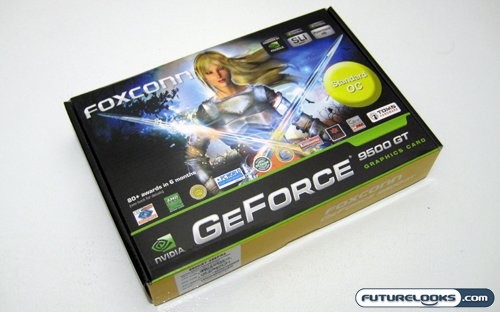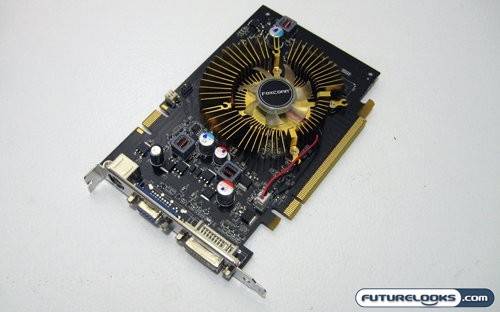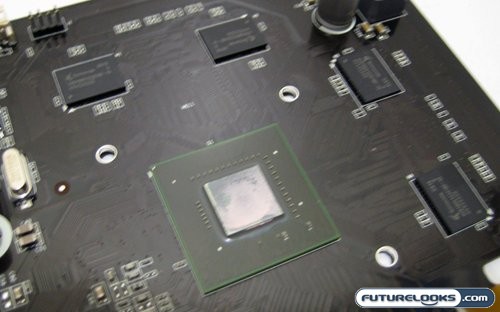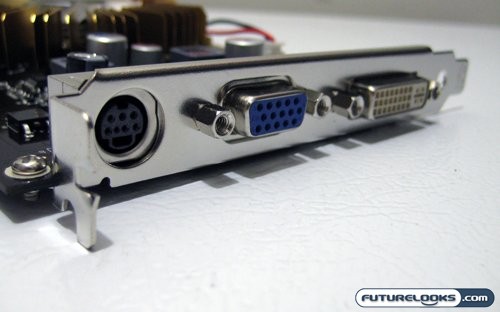
Positioned slightly below the GeForce 9600GT, the GeForce 9500GT represents NVIDIA’s contribution to the mainstream and budget market in the current generation of chipsets. As noted above, this means that these cards tend to be found in systems where heavy duty graphics performance may not be needed or expected. That doesn’t mean these cards are any slouch in performance, as they are still better then most onboard and integrated video solutions. I just wouldn’t expect any miracles when placed up against higher end video cards. Luckily the average price on these cards does reflect any performance short comings. They are typically priced between $20 and $50 USD cheaper than a 9600 GT based card.

As for our review unit, it was kindly provided by FOXCONN. The 9500GT-256FR3 OC video card, as it’s name would imply, is factory overclocked and includes 256MB of GDDR3 RAM. The card also sports HDCP compliance, and supports DX10 Shader Model 4.0. For more info and specifications, check out the product home page. As for the card itself, the Foxconn 9500GT-256FR3 OC harkens back to the day when you could actually see most of the PCB of your video card. All joking aside, this video card is a fairly simple affair. There’s a large, actively cooled heatsink mounted to the GPU, and the memory sitting out in the open.

The heatsink is easily removed by simply undoing four screws from the rear of the card, should you want to install an aftermarket cooler. We just wanted to take a peak under the hood, as it were. One thing that is interesting is that this 9500GT card is based on the new G96 core, which is fabricated on a 55nm process. That would explain the remarkably small GPU package.

To connect a display to the Foxconn 9500GT card, you are provided with a selection of ports that are typical for this class of card. From right to left you have a DVI port, VGA port, and the HD output. It’s kind of strange to see a VGA port these days, even on budget-minded cards. Many cards, even those in this price range, have changed over to dual DVI to better support those who need large displays without concern for 3D performance. Another adaptor that is missing, though unsurprisingly, is the secondary power adapter. The 9500GT and the cards based on it do typically need any more power then what is provided from the PCI slot.
If you are still so inclined, you can run the 9500GT in SLI. It only does support dual-card SLI, but if you want a performance boost down the road the option is open. Due to the size of this card everything is pretty well compacted together, and right next to the SLI connector is the S/PDIF plug. This is for a feed from your sound card, so you can pass audio through the HDMI port when connected to an HDTV.
Real-Time Price and Stock Check – Find More FOXCONN Products
What Else is in The Box?
The accessories included with the Foxconn 9500GT-256FR3 OC video card are pretty well the bare minimum expected to come with a video card. That isn’t a bad thing, as this card seems aimed at providing the least expensive dedicated video card. There’s a DVI-to-VGA adapter and video output cable included. The CD contains drivers and Foxconn’s own tweaking software, and the user manual is fairly thin and covers the basics of installation and setup.
Benchmarks and Testing
To test the Foxconn 9500GT-256FR3 OC video card, I installed it into my current test rig. I installed the latest NVIDIA drivers available to run this card. The components for my test rig go something like this.
- AMD Phenom 9850 2.5GHz Quad Core CPU
- Asus M3A32-MVP Deluxe/WiFi-AP 790FX Motherboard
- Corsair Dominator DDR2 4GB PC2-8500 RAM Kit
- Western Digital VelociRaptor 300GB 10000rpm SATA2 Hard Drive
- Cooler Master Hyper 212 CPU Cooler
- HighSpeed PC Top Deck Tech Station
- Microsoft Windows Vista Ultimate x64 SP1
The choice of an x64 version of Vista for testing is necessitated by the use of 4GB of RAM in our test rig. As for video cards to compare the 9500 GT against, I figured it would be cruel to put in up against the GTX 260 and GTX 280 we reviewed, so I pitted it against the other 9000 series NVIDIA cards we’ve reviewed. If you want to cross reference the results to see where the 9500GT sits in the grand scheme, check out the various video card reviews we’ve done.
Our first test is the truly old 3DMark06. This long used and oft-never-forgotten synthetic benchmark tests DirectX 9 performance. Our tests have always been ran at 1680×1050, with all other settings left to default. Even at that, the Foxconn 9500GT posted a result that was 47% slower then the 9600GT card. This isn’t that surprising, as the 9500GT is, in almost every spec, essentially half of its bigger brother. It has half the stream processors, less then half of the fillrate, half the RAM, and so on.
3DMark Vantage is a full replacement for 3DMark06, sporting the latest DirectX 10 features and tests. Since the 9500GT is a DX10 compatible card, it has to be thrown into the ring and ravaged by this much harsher benchmark. I thought for sure 3DMark Vantage would do in the 9500GT, but the trend of half performance continued. The score posted by the 9500GT is almost 50% of the score of the 9600GT we used. This does show some promise, though this is only the “Performance” score, and is only run at 1280×1024.
I did try running this card through the “High” test in 3DMark Vantage, but it just couldn’t do it. It crashed twice on me. That’s understandable as the “High” test ramps the resolution up to 1680×1050, and kicks the detail settings up a notch or two. So with those results, it’s time to turn things over to our real world tests.
Real-Time Price and Stock Check – Find More FOXCONN Products
BioShock
First up on the list is the first person shooter BioShock. This game is a DX9 title, but it does employ some DX10 tricks. For testing, we ran through a quick battle in one of the final areas. The Foxconn 9500GT-256FR3 OC video card held up decently in these tests, though it did lag out on some more intensive scenes. Averaging 30 FPS does provide for an OK gaming experience, but really 60 FPS is where you want your average to be. That way game play doesn’t drop to slide show mode in a particularly heated battle.
In-game picture quality was still what we’ve come to expect from NVIDIA. When the game was running smoothly, it still managed to impress. Still this final battle is light on the water effects, and I’d be worried about stepping into some of the more graphically intense areas of the game.
Cal of Duty 4
When we wanted to switch to a more realistic mode of combat, we started up Call of Duty 4. It still managed to tell the same story of performance. CoD4 does tend to have a little more going on during gameplay, so it’s performance numbers are in turn lower. It was playable, but I got to personally experience a couple of slide show moments.
For testing, I of course kept all the detail settings at the levels we use in all our tests. The game did look quite nice, but it would have been very difficult to play competitively. I tweaked the CoD4 options, and was able to get a more manageable frame rate, at the cost of some picture quality.
Real-Time Price and Stock Check – Find More FOXCONN Products
Supreme Commander
After all this it was nice to see some light at the end of the tunnel, in the form of the game known as Supreme Commander. The RTS title has a significant impact on all systems in a computer, including video card, CPU, and RAM. This makes it a good all around benchmark. The score outputted by the benchmark mode is a composite score. In the case of the 9500GT, the score was only 17% slower then the same test rig with the 9600GT card. That score of course takes into account CPU, RAM, and other factors. We taking a look at the FPS separately, SupCom still only managed to average about 30 FPS. This isn’t a bad thing, since low frame rates don’t affect gameplay as much in RTS titles as they do in first person titles.
The afore mentioned light at the end of the tunnel turned out to be the bright flash from a nuclear detonation. These effects are some of the more punishing present in Supreme Commander. It was nice that I didn’t have to reduce the settings too much to enjoy their destructive beauty.
Crysis
The final game in our melange of tests is the one and only Crysis. This is a good example of me being cruel and unusual, as at the settings used for our benchmarks there’s no way I could expect the 9500GT card to run this game. Cranking the resolution way down and shutting off much of the eye candy did result in a playable experience…
…but it looked nothing like this. Games like Crysis unfortunately need hefty graphics subsystems to make them work at full speed while looking the way they are supposed to look. I think I should end it there. Let’s wrap this up.
Real-Time Price and Stock Check – Find More FOXCONN Products
Final Thoughts and Conclusion
So I think it’s safe to say that we have proven this card isn’t a performance champ. When compared to faire like the Radeon 4850 and GeForce GTX 260, it just simply can’t compete. However, when you think about it, the Foxconn 9500GT-256FR3 OC video card really isn’t for the markets those cards serve. This card is for casual gamers, or those trying to escape the shackles of integrated graphics hell.
The Foxconn 9500GT-256FR3 OC video card does support all the features you would expect on a modern NVIDIA graphics card. It’s fully compatible with DX10, and will serve you well in a budget Vista box. It also sports PureVideo, which is something sought after by the Home Theatre PC crowd. Given the right amount of tweaking, it can even serve as a gaming card in a limited fashion, and like most NVIDIA cards is expandable via SLI.
About the only market this card does not benefit is those gamers who have graduated to playing titles like CoD4, TF2, and Crysis, in high resolutions. Other then the performance issues raised by that, there’s little wrong with this card. The only other thing that comes to mind is the lack of Dual DVI. Desktop users still like big monitors, and dual monitors. Oh and though this card supports HDMI and HDCP, there isn’t an adapter included to go from DVI to HDMI.
In the end, the GeForce 9500GT has found itself in a nice position as a budget card for the budget minded and non-hardcore. At $60 – $80 USD, it’s hard to deny the appeal of such a unit, especially when you are sitting on an older card or integrated graphics solution. It may not have the chops to play with the big boys of the 3D shooter world, but it’ll play your media and work well in your computer without being noticed. And really, the people who aren’t yelling “Boom: Headshot” every five minutes are the ones who want that kind of serenity.
Pros
- Very inexpensive
- Single slot, no additional power needed
- Runs quiet
- OK performance
Cons
- Only one DVI port
- No HDMI adapter
Overall Rating: 8.0/10.0
Discuss This Review in the Futurelooks Community Forums
Real-Time Price and Stock Check – Find More FOXCONN Products
Foxconn 9500GT-256FR3 OC Video Card Photo Gallery
Real-Time Price and Stock Check – Find More FOXCONN Products
